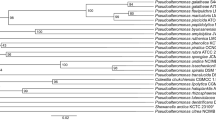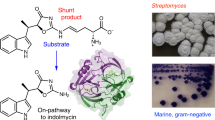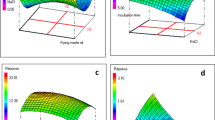Abstract
Polybrominated diphenyl ethers (PBDEs) and polybrominated bipyrroles are natural products that bioaccumulate in the marine food chain. PBDEs have attracted widespread attention because of their persistence in the environment and potential toxicity to humans. However, the natural origins of PBDE biosynthesis are not known. Here we report marine bacteria as producers of PBDEs and establish a genetic and molecular foundation for their production that unifies paradigms for the elaboration of bromophenols and bromopyrroles abundant in marine biota. We provide biochemical evidence of marine brominases revealing decarboxylative-halogenation enzymology previously unknown among halogenating enzymes. Biosynthetic motifs discovered in our study were used to mine sequence databases to discover unrealized marine bacterial producers of organobromine compounds.
This is a preview of subscription content, access via your institution
Access options
Subscribe to this journal
Receive 12 print issues and online access
$259.00 per year
only $21.58 per issue
Buy this article
- Purchase on Springer Link
- Instant access to full article PDF
Prices may be subject to local taxes which are calculated during checkout






Similar content being viewed by others
Accession codes
Primary accessions
NCBI Reference Sequence
Referenced accessions
GenBank/EMBL/DDBJ
References
Gribble, G.W. The natural production of organobromine compounds. Environ. Sci. Pollut. Res. Int. 7, 37–47 (2000).
Gribble, G.W. Naturally Occurring Organohalogen Compounds—a Comprehensive Update. Vol. 91 (Springer Vienna, 2010).
Liu, Y.N. et al. Spatial and temporal distributions of bromoform and dibromomethane in the Atlantic Ocean and their relationship with photosynthetic biomass. J. Geophys. Res.–Oceans 118, 3950–3965 (2013).
Al-Mourabit, A., Zancanella, M.A., Tilvi, S. & Romo, D. Biosynthesis, asymmetric synthesis, and pharmacology, including cellular targets, of the pyrrole-2-aminoimidazole marine alkaloids. Nat. Prod. Rep. 28, 1229–1260 (2011).
Gaul, S. et al. Identification of the natural product 2,3,4,5-tetrabromo-1-methylpyrrole in Pacific biota, passive samplers and seagrass from Queensland, Australia. Mar. Pollut. Bull. 62, 2463–2468 (2011).
Kitamura, M., Koyama, T., Nakano, Y. & Uemura, D. Corallinafuran and Corallinaether, novel toxic compounds from crustose coralline red algae. Chem. Lett. 34, 1272–1273 (2005).
Kuniyoshi, M., Yamada, K. & Higa, T. A biologically-active diphenyl ether from the green-alga Cladophora fascicularis. Experientia 41, 523–524 (1985).
Malmväm, A., Zebuhr, Y., Kautsky, L., Bergman, K. & Asplund, L. Hydroxylated and methoxylated polybrominated diphenyl ethers and polybrominated dibenzo-p-dioxins in red alga and cyanobacteria living in the Baltic Sea. Chemosphere 72, 910–916 (2008).
King, G.M., Giray, C. & Kornfield, I. Biogeographical, biochemical and genetic differentiation among North-American Saccoglossids (Hemichordata, Enteropneusta, Harrimaniidae). Mar. Biol. 123, 369–377 (1995).
Unson, M.D., Holland, N.D. & Faulkner, D.J. A brominated secondary metabolite synthesized by the cyanobacterial symbiont of a marine sponge and accumulation of the crystalline metabolite in the sponge tissue. Mar. Biol. 119, 1–11 (1994).
Calcul, L. et al. NMR strategy for unraveling structures of bioactive sponge-derived oxy-polyhalogenated diphenyl ethers. J. Nat. Prod. 72, 443–449 (2009).
Löfstrand, K. et al. Brominated phenols, anisoles, and dioxins present in blue mussels from the Swedish coastline. Environ. Sci. Pollut. Res. Int. 17, 1460–1468 (2010).
Vetter, W., Scholz, E., Gaus, C., Müller, J.F. & Haynes, D. Anthropogenic and natural organohalogen compounds in blubber of dolphins and dugongs (Dugong dugon) from northeastern Australia. Arch. Environ. Contam. Toxicol. 41, 221–231 (2001).
Marsh, G. et al. Identification, quantification, and synthesis of a novel dimethoxylated polybrominated biphenyl in marine mammals caught off the coast of Japan. Environ. Sci. Technol. 39, 8684–8690 (2005).
Teuten, E.L., Xu, L. & Reddy, C.M. Two abundant bioaccumulated halogenated compounds are natural products. Science 307, 917–920 (2005).
Wan, Y. et al. Origin of hydroxylated brominated diphenyl ethers: natural compounds or man-made flame retardants? Environ. Sci. Technol. 43, 7536–7542 (2009).
Ren, X.M. & Guo, L.H. Molecular toxicology of polybrominated diphenyl ethers: nuclear hormone receptor mediated pathways. Environ. Sci. Process. Impacts 15, 702–708 (2013).
Isnansetyo, A. & Kamei, Y. MC21-A, a bactericidal antibiotic produced by a new marine bacterium, Pseudoalteromonas phenolica sp. nov. O-BC30T, against methicillin-resistant Staphylococcus aureus. Antimicrob. Agents Chemother. 47, 480–488 (2003).
Andersen, R.J., Wolfe, M.S. & Faulkner, D.J. Autotoxic antibiotic production by a marine chromobacterium. Mar. Biol. 27, 281–285 (1974).
Burkholder, P.R., Pfister, R.M. & Leitz, F.H. Production of a pyrrole antibiotic by a marine bacterium. Appl. Microbiol. 14, 649–653 (1966).
Holmström, C. & Kjelleberg, S. Marine Pseudoalteromonas species are associated with higher organisms and produce biologically active extracellular agents. FEMS Microbiol. Ecol. 30, 285–293 (1999).
Vetter, W. Polyhalogenated alkaloids in environmental and food samples. Alkaloids Chem. Biol. 71, 211–276 (2012).
Rypien, K.L., Ward, J.R. & Azam, F. Antagonistic interactions among coral-associated bacteria. Environ. Microbiol. 12, 28–39 (2010).
Dorrestein, P.C., Yeh, E., Garneau-Tsodikova, S., Kelleher, N.L. & Walsh, C.T. Dichlorination of a pyrrolyl-S-carrier protein by FADH2-dependent halogenase PltA during pyoluteorin biosynthesis. Proc. Natl. Acad. Sci. USA 102, 13843–13848 (2005).
Peschke, J.D., Hanefeld, U. & Laatsch, H. Biosynthesis of the marine antibiotic pentabromopseudilin. 2. The pyrrole ring. Biosci. Biotechnol. Biochem. 69, 628–630 (2005).
Lucas-Elío, P. et al. Complete genome sequence of the melanogenic marine bacterium Marinomonas mediterranea type strain (MMB-1T). Stand. Genomic Sci. 6, 63–73 (2012).
Donia, M.S., Fricke, W.F., Ravel, J. & Schmidt, E.W. Variation in tropical reef symbiont metagenomes defined by secondary metabolism. PLoS ONE 6, e17897 (2011).
Sorokin, D.Y., Tourova, T.P., Lysenko, A.M., Mityushina, L.L. & Kuenen, J.G. Thioalkalivibrio thiocyanoxidans sp. nov. and Thioalkalivibrio paradoxus sp. nov., novel alkaliphilic, obligately autotrophic, sulfur-oxidizing bacteria capable of growth on thiocyanate, from soda lakes. Int. J. Syst. Evol. Microbiol. 52, 657–664 (2002).
Walsh, C.T., Garneau-Tsodikova, S. & Howard-Jones, A.R. Biological formation of pyrroles: nature's logic and enzymatic machinery. Nat. Prod. Rep. 23, 517–531 (2006).
Buedenbender, S., Rachid, S., Muller, R. & Schulz, G.E. Structure and action of the myxobacterial chondrochloren halogenase CndH: a new variant of FAD-dependent halogenases. J. Mol. Biol. 385, 520–530 (2009).
van Pée, K.H. Enzymatic chlorination and bromination. Methods Enzymol. 516, 237–257 (2012).
Eichhorn, E., van der Ploeg, J.R. & Leisinger, T. Characterization of a two-component alkanesulfonate monooxygenase from Escherichia coli. J. Biol. Chem. 274, 26639–26646 (1999).
Blasiak, L.C. & Drennan, C.L. Structural perspective on enzymatic halogenation. Acc. Chem. Res. 42, 147–155 (2009).
Gribble, G.W. Occurrence of halogenated alkaloids. Alkaloids Chem. Biol. 71, 1–165 (2012).
Hanefeld, U., Floss, H.G. & Laatsch, H. Biosynthesis of the marine antibiotic pentabromopseudilin. 1. The benzene-ring. J. Org. Chem. 59, 3604–3608 (1994).
Walsh, C.T. & Wencewicz, T.A. Flavoenzymes: versatile catalysts in biosynthetic pathways. Nat. Prod. Rep. 30, 175–200 (2013).
Hewson, W.D. & Hager, L.P. Bromoperoxidases and halogenated lipids in marine-algae. J. Phycol. 16, 340–345 (1980).
Borchardt, S.A. et al. Reaction of acylated homoserine lactone bacterial signaling molecules with oxidized halogen antimicrobials. Appl. Environ. Microbiol. 67, 3174–3179 (2001).
Beissner, R.S., Guilford, W.J., Coates, R.M. & Hager, L.P. Synthesis of brominated heptanones and bromoform by a bromoperoxidase of marine origin. Biochemistry 20, 3724–3731 (1981).
Fehér, D., Barlow, R., McAtee, J. & Hemscheidt, T.K. Highly brominated antimicrobial metabolites from a marine Pseudoalteromonas sp. J. Nat. Prod. 73, 1963–1966 (2010).
Mas, S. et al. Comprehensive liquid chromatography-ion-spray tandem mass spectrometry method for the identification and quantification of eight hydroxylated brominated diphenyl ethers in environmental matrices. J. Mass Spectrom. 42, 890–899 (2007).
Makino, M. et al. Crystal structures and catalytic mechanism of cytochrome P450 StaP that produces the indolocarbazole skeleton. Proc. Natl. Acad. Sci. USA 104, 11591–11596 (2007).
Ballou, D.P., Entsch, B. & Cole, L.J. Dynamics involved in catalysis by single-component and two-component flavin-dependent aromatic hydroxylases. Biochem. Biophys. Res. Commun. 338, 590–598 (2005).
Eppink, M.H., Cammaart, E., Van Wassenaar, D., Middelhoven, W.J. & van Berkel, W.J. Purification and properties of hydroquinone hydroxylase, a FAD-dependent monooxygenase involved in the catabolism of 4-hydroxybenzoate in Candida parapsilosis CBS604. Eur. J. Biochem. 267, 6832–6840 (2000).
Eppink, M.H., Boeren, S.A., Vervoort, J. & van Berkel, W.J. Purification and properties of 4-hydroxybenzoate 1-hydroxylase (decarboxylating), a novel flavin adenine dinucleotide-dependent monooxygenase from Candida parapsilosis CBS604. J. Bacteriol. 179, 6680–6687 (1997).
Blunt, J.W., Copp, B.R., Keyzers, R.A., Munro, M.H. & Prinsep, M.R. Marine natural products. Nat. Prod. Rep. 30, 237–323 (2013).
Wiseman, S.B. et al. Polybrominated diphenyl ethers and their hydroxylated/methoxylated analogs: environmental sources, metabolic relationships, and relative toxicities. Mar. Pollut. Bull. 63, 179–188 (2011).
Ucán-Marin, F., Arukwe, A., Mortensen, A.S., Gabrielsen, G.W. & Letcher, R.J. Recombinant albumin and transthyretin transport proteins from two gull species and human: chlorinated and brominated contaminant binding and thyroid hormones. Environ. Sci. Technol. 44, 497–504 (2010).
Meerts, I.A. et al. Potent competitive interactions of some brominated flame retardants and related compounds with human transthyretin in vitro. Toxicol. Sci. 56, 95–104 (2000).
Dorrestein, P.C. & Kelleher, N.L. Dissecting non-ribosomal and polyketide biosynthetic machineries using electrospray ionization Fourier-Transform mass spectrometry. Nat. Prod. Rep. 23, 893–918 (2006).
John, E.A., Pollet, P., Gelbaum, L. & Kubanek, J. Regioselective syntheses of 2,3,4-tribromopyrrole and 2,3,5-tribromopyrrole. J. Nat. Prod. 67, 1929–1931 (2004).
Markowitz, V.M. et al. IMG ER: a system for microbial genome annotation expert review and curation. Bioinformatics 25, 2271–2278 (2009).
Kouprina, N. & Larionov, V. Selective isolation of genomic loci from complex genomes by transformation-associated recombination cloning in the yeast Saccharomyces cerevisiae. Nat. Protoc. 3, 371–377 (2008).
Gust, B., Challis, G.L., Fowler, K., Kieser, T. & Chater, K.F. PCR-targeted Streptomyces gene replacement identifies a protein domain needed for biosynthesis of the sesquiterpene soil odor geosmin. Proc. Natl. Acad. Sci. USA 100, 1541–1546 (2003).
Li, D.B. et al. Chapter 19. In vitro studies of phenol coupling enzymes involved in vancomycin biosynthesis. Methods Enzymol. 458, 487–509 (2009).
Acknowledgements
We thank our colleagues E. Frick for preliminary in vitro studies with Bmp6, B.M. Duggan for assistance in NMR data collection, P.A. Jordan for NMR data analysis, Y. Su for MS data collection and L.I. Aluwihare for useful discussions. This work was jointly supported by the US National Science Foundation (OCE-1313747) and the US National Institute of Environmental Health Sciences (P01-ES021921) through the Oceans and Human Health program, the Gordon and Betty Moore Foundation Marine Microbial Sequencing Project, the Helen Hay Whitney Foundation postdoctoral fellowship to V.A., the US National Institutes of Health (NIH) Marine Biotechnology Training Grant predoctoral fellowship to A.A.E. (T32-GM067550) and an NIH instrument grant (S10-RR031562).
Author information
Authors and Affiliations
Contributions
V.A., A.A.E., E.E.A. and B.S.M. designed research; V.A., A.A.E. and K.Y. performed genetic experiments; V.A., A.A.E. and R.D.K. performed in vitro experiments; M.S. and E.E.A. generated sequencing data; D.P. contributed new analytical reagents; and V.A., A.A.E., E.E.A. and B.S.M. analyzed data and wrote the manuscript.
Corresponding author
Ethics declarations
Competing interests
The authors declare no competing financial interests.
Supplementary information
Supplementary Text and Figures
Supplementary Results, Supplementary Notes 1 and 2, Supplementary Figures 1–30 and Supplementary Tables 1–5. (PDF 4750 kb)
Rights and permissions
About this article
Cite this article
Agarwal, V., El Gamal, A., Yamanaka, K. et al. Biosynthesis of polybrominated aromatic organic compounds by marine bacteria. Nat Chem Biol 10, 640–647 (2014). https://doi.org/10.1038/nchembio.1564
Received:
Accepted:
Published:
Issue Date:
DOI: https://doi.org/10.1038/nchembio.1564
This article is cited by
-
Site-selective chlorination of pyrrolic heterocycles by flavin dependent enzyme PrnC
Communications Chemistry (2024)
-
Linking bacterial tetrabromopyrrole biosynthesis to coral metamorphosis
ISME Communications (2023)
-
Plastoquinone synthesis inhibition by tetrabromo biphenyldiol as a widespread algicidal mechanism of marine bacteria
The ISME Journal (2023)
-
Mechanism-guided tunnel engineering to increase the efficiency of a flavin-dependent halogenase
Nature Catalysis (2022)
-
Molecular Relationships in Biofilm Formation and the Biosynthesis of Exoproducts in Pseudoalteromonas spp.
Marine Biotechnology (2022)



